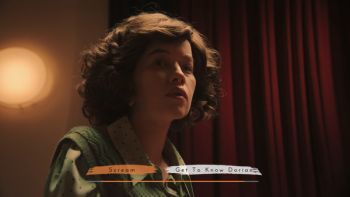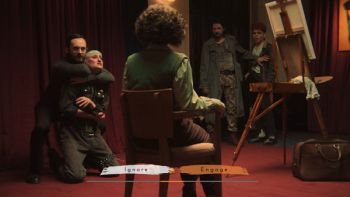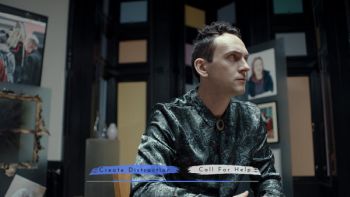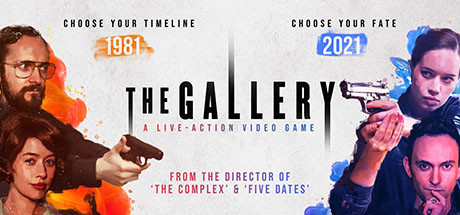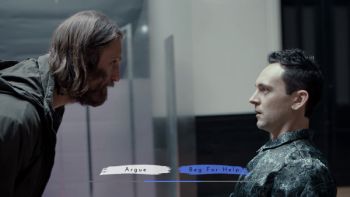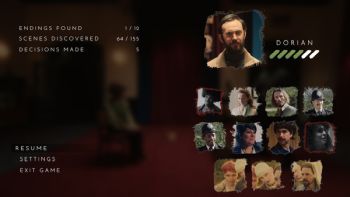|
By flotsam
The Gallery
Paul Raschid Media / Aviary
Studios
Self described as a “live-action
(FMV) game/interactive film,” there is definitely a lot to like about
The Gallery. It is though very much an interactive film, your ‘game
play’ being limited to making choices at various points about how the
character in question should respond or act in the particular scene.
While there is certainly a degree of pondering and reflecting about what
might be a preferred response in the context of the developing
narrative, you choose and watch the film unfold, which is the extent of
things. Be aware of that going in and a polished product awaits.
The basic premise revolves
around two people... Morgan, the proprietor of a UK portrait
gallery who is soon to exhibit a new portrait by a Turner Prize winning
artist, and Dorian, an artist ‘insistent’ on painting Morgan’s portrait.
There is a more extensive cast and a whole lot more going on, not least
of all the societal unrest in the world outside, but best that you
uncover all that should you choose to play. I try and avoid knowing
anything but the barest information about new films I might watch, and
the same applies here.
Or rather, the basic premise
involves two proprietors being painted by two artists, 40 years apart.
Your very first choice is
whether to play a female proprietor in 1981, or a male proprietor in
2021. I chose the female, which resulted in the protagonist artist being
male, and about 80 minutes later I got an ending I wasn’t expecting, and
some surprising developments along the way. I also learned that my
ending was one of twelve possible endings, and that I had seen only a
third of all possible scenes.
I was aware as I went that
certain decisions were impacting the story. Pop-up messages like ‘story
affected’ or ‘relationship consequence’ appeared from time to time,
sometimes after making a choice but sometimes as particular scenes
played out. The nature of one particular relationship goes up and down,
depending on how a decision has affected it. It seemed apparent early on
that there was probably value in trying to keep that relationship as
positive as possible.
I don’t think I needed or wanted
the messaging – there were times when they seemed obvious and redundant
- but they do help somewhat when/if you try to achieve another ending or
endeavour to generate some of those other scenes. Which I did.
But not before I played the
other timeframe and the male proprietor, which came with a whole other
surprise. Which was that the lead characters had flipped roles. The
proprietor was still named Morgan, but was now a male played by the
actor who had been Dorian first time around. And vice versa. It was
rather neat, and more than just a gimmicky bit of casting. Gender
‘fluidity’ is clearly deliberate, and it plays out elsewhere through the
film. It added thoughtfully to the mix.
Many of the scenes I saw when I
played the 2021 timeframe were heavily familiar, including the dialogue.
But they weren’t exactly the same, the differences in time and gender
doing enough to subtly shift various nuances involved. Not always, but
often, and it was inherently interesting in itself just to see how a
scene impacted you as the viewer when the gender of the character
changed. As I said, a thoughtful addition to the mix.
If you are like me, you may well
think ‘I have seen this’ and might then be tempted to factor your
alt-timeline response into this decision tree as a result. That may be
appropriate, but those subtle nuances I referred to might make all the
difference. Or maybe not. You will have to choose accordingly and then
see.
My ending was different than in
the other timeline, one of six apparently available over here. I still
had a lot more scenes to uncover.
I then replayed 1981, which now
allowed me to Tab through any scene I had watched earlier. I suspect I
will avail myself of that down the track, but not yet. This is a movie,
and jumping through scenes is too disruptive.
In the same timeframe you can be
more certain about the things seen and done previously; however the
cumulative effect of earlier decisions might well affect how a later
different decision plays out, or maybe even a later same decision. How
tangled and interdependent the threads are you would only be able to
tell after numerous play throughs; however the 150 decision points and
the “relationship tracking mechanic” suggests it isn’t a simplistic
either/or situation.
Perhaps not surprisingly I got a
different end again. Ten more in 1981 to go!
It isn’t all about the endings.
Other storylines and character interactions can play out differently as
well, in fairly significant ways. On my second 1981 play through I came
across three entirely new characters, and profoundly impacted the arc of
two others. The number of yet to be discovered scenes suggest a plethora
of alternatives await.
You may well recognise a number
of the actors, including the leads, from various TV ventures, and their
acting backgrounds show. Give or take a special effect or two,
everything about the film that unfolds is top notch. The sense of place
in the different timelines is well designed, the attention paid to
portraiture is apparent and conveyed, and the framing used in some shots
is impactful. If at times either available response seemed a little out
of character, it was a small thing given the number in play. And as
already noted, it has a capacity to surprise, and the writing and the
various story arcs I have come across seems certain to deliver a few
more.
You can choose to play with a
time limit in which to make your response, or to take as long as you
like. The former is the most natural way to proceed, as there is no
break or pause in the particular scene. The characters continue with
their dialogue, and you have either made your choice by the time it is
needed or you haven’t, at which point it is made for you and the
character/s move on. You can see how much time you have by a reducing
red line just underneath the available choices. If you play with no time
limit, the unfolding scene will pause if you haven’t made a decision
when its needed, and simply continue when you have.
You can tweak a few things in
the settings and play with or without subtitles. There are no manual
saves, and while I never could tell when it had autosaved and ended up
replaying some small sections as a result, it was again a small thing. I
tended to exit after a decision point or action that affected the story
in some way, and that seemed to work well, and it probably warrants
playing straight through the first few times in any event.
While I really wanted more to
do, The Gallery does what it does really well.
I played on:
OS: Windows 10, 64 Bit
Processor: Intel i7-9700K 3.7GHz
RAM: Corsair Dominator Platinum RGB DDR4 32GB
Video card: AMD Radeon RX 580 8192MB
GameBoomers Review Guidelines
September 2022
design copyright© 2022
GameBoomers
Group
 GB
Reviews Index GB
Reviews Index |
